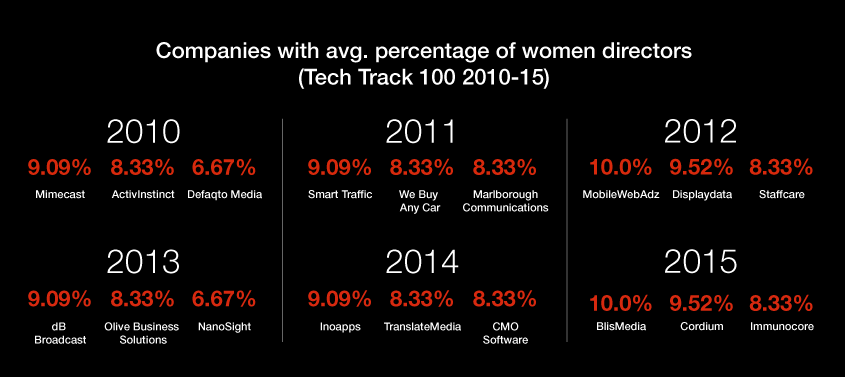
Data shows women leaders still scarce in the tech industry

Analysing some 750[1] tech, media and telecoms companies that have appeared in the Tech Track 100 rankings from the last 15 years, we looked at how many director roles are occupied by women.
We found that while there was an increase in the number of women in director roles, the average percentage of women in these roles remained under 10% over the same time period.

Looking at the data, one thing is clear. The growth of women in senior roles in the tech industry is not significant enough. So why does this percentage remain so low?
A tough climb to the top
One theory for the lack of women in top tech roles is that they’re overlooked when promotional opportunities arrive. According to Anne-Marie Imafidon, founder and CEO for stemettes.org (external link), an organisation that helps put girls in contact with women working in science, technology, engineering and mathematics (STEM) industries, the struggle to push past the 10% mark is down to a lack of promotions at more junior levels.
"[The number of women in director roles] has remained stable as women aren’t being promoted and given positions of responsibility in line with the proportion of women at more junior levels in the industry. As well as this, the number of women entering the tech industry has been declining in recent years," says Imafidon.
So if Imafidon is right, when faced with a seeming reticence within the industry to promote women, it could be that fewer women take on the tough climb up the corporate ladder or choose to enter the industry at all.
In order to tackle the problem, Imafidon believes that biases within recruitment must first be ironed out.
"Tech companies need to make sure that they have the right processes for promotion and recruitment which mean that they don’t have bias. Having balanced promotion and interview panels, as well as employing the Rooney Rule – a concept from American football, where a panel interviews at least one minority candidate for senior roles – can help with this."

A reduced talent pool
As we know, the average number of women within top roles in tech remains low. But, according to the data, this low average is the result of a rise and fall in the number of women directors across different sectors each year, rather than consistent under-employment in certain areas.
Without enough women rising through the ranks in each sector, the tech industry can’t sustain any growth it experiences.
Theresa McHenry (external link), HR Director at Microsoft, puts the lack of sustained growth down to a reduced applicant pool.
"There are challenges for the industry. The market for senior female talent is increasingly competitive and companies are recruiting from a smaller subset of technical female talent."
According to McHenry, only long term investment in female talent will have any transformative effect on its presence in top industry roles.
"It needs sustained effort and investment, you can’t take a one-off approach to hiring or promoting women into senior roles. Companies won’t sustain senior female representation unless they invest in building a pipeline of talent for the future.
"That means, in the short term, developing and progressing careers of middle managers and, in the longer term, investing early in education and educational initiatives which nurture talent and show off opportunities available to young girls."
In-roads in software development
While the overall picture of women in tech isn’t promising, what we can see from the data is that the software sector crops up a number of times as a field that regularly employs women in top roles, if only in low numbers.
Software covers a variety of disciplines and over the past five years, compliance, e-commerce and financial software developers have each employed the average number of women directors (8.73%). McHenry believes the lack of legacy issues in the software industry, in terms of gender bias, has contributed to a more inclusive environment for women.
"Software development is a newer industry, made up of younger organisations and start-ups that have less history and cultural past to overcome. Our digital economy is driven by good ideas and good ideas can come from anyone, at any stage in life and whatever their background.
"The typical culture in this sector is dynamic and empowering, and the work environment offers autonomy, innovation and creativity."
Meanwhile, Imafidon attributes the findings to the skillset of women who choose careers within the software industry.
"In general, women who enter software development teams have a broad range of skills that they bring to the table. Some of these include communication and leadership skills that are invaluable for an organisation if they’re to have good software development teams.
"There is a natural progression from development manager to development director – this is what we’re seeing in the numbers."
New markets, new opportunities
Featuring an abundance of ground-breaking technologies, software innovations and disruptive services over the last decade and a half, the Tech Track 100 has had to incorporate new categories for these tech companies, to reflect an ever-transforming sector.
The following graphic shows Tech Track featured industries from the last 15 years with the highest percentages of women in director roles. These sectors, such as payment software and digital marketing, reflect the arrival and rising influence of innovative markets in the industry over the years.

According to McHenry, the transformation of the tech industry has created new territories and, potentially, new opportunities for women to explore. But the problem of available female talent remains.
"This data shows the diversification in the industry and the dynamic merging, divestiture and start-up environment in play. It’s an area of high employment and growth which creates more opportunities than there is a pipeline of women to fill.
"The culture and nature of the workplace is attractive to women, but currently we aren’t training enough women to fill the growing number of available roles."
A long haul commitment
We can see some headway has been made in bringing women into software, but the tech industry as a whole has a long way to go if it is to tackle the 15-year low in top tech roles among women.
While the data merely outlines this trend, many place responsibility for the results on environmental factors within the industry. Both McHenry of Microsoft and Imafidon of Stemettes, attribute this low figure to a lack of consistent and committed support for women, including opportunities for career progression, investment in young talent and training opportunities.
Effectively resolving the gender imbalance in the workplace needs long term, dedicated effort on all sides, it seems, all the way from education to employment. Only then will it be able to challenge the perceived narrowness of women’s hold on the tech sector.
Find out more about Tech Track 100 and Women leaders in tech.
Learn more about our commercial business insurance or if you run an IT-focused company or deal in sensitive data, discover more about our protection against cyber and data risks.
[1] This is a representative sample of all companies featured in the Tech Track 100 league from 2001 to 2015. The sample consists of all Tech Track companies from 2001 to 2015 that are listed with Companies House.
Disclaimer:
At Hiscox, we want to help your small business thrive. Our blog has many articles you may find relevant and useful as your business grows. But these articles aren’t professional advice. So, to find out more on a subject we cover here, please seek professional assistance.





